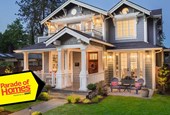
Key insights:
- Some homes may be easy to insure, while aging homes and homes with defects may require a policy with depreciated coverage.
- Homeowners in flood zones will have to take out an additional policy to cover their property from flooding.
- By working directly with an insurance agent, homeowners can be sure that their home is thoroughly and adequately insured.
Of all the items on a homebuyer’s checklist of to-dos, homeowner’s insurance is one of the most common. While most homes in Minnesota and western Wisconsin are easily covered under a standard homeowner’s insurance policy, there are some exceptions. So, which types of homes may be difficult (or even impossible) to insure?
Older or damaged homes
Homes that are in declining condition may be difficult to insure, said Scott Teece, vice president of Edina Realty Insurance. “We often see that insurance carriers are hesitant to fully cover older homes, damaged homes or homes that have an older roof. They may also hesitate to cover a home with damage to the siding.”
Insurance carriers are beginning to limit coverage on these damaged homes, so they would offer only the depreciated value, rather than the full replacement cost, if the roof or damaged area needed to be fully replaced.
Homes with “attractive nuisances”
We all know the houses in our neighborhood that have the most exciting features or attractions — whether they be pools, hot tubs, trampolines, or something else altogether. Insurance companies like to know about those features as well, because they make a property riskier to insure.
Of course, that doesn’t mean that all pool owners are uninsured, or that your trampoline will remain an uninsured liability every time the neighbor kid comes over to jump. In most cases, said Teece, “a property with a pool needs to be fenced in and have a cover, and a trampoline needs to be anchored to the ground and have a net surrounding it. By taking these precautions, most companies will agree to cover the home. Without that protection, they may reject coverage.”
Homes that aren’t near a fire station
Homes are evaluated on their insurance protection class, said Teece, which is a rating system that ranks how likely the responding fire department will be able to get to the property, or put out the fire. Homes are given a ranking from 1 (the best) to 10 (the worst) when they are being evaluated for coverage.
“Homes that are ranked a 9 or 10 may have a hard time getting insured,” said Teece. “However, that’s a factor that would be identified early on in the home buying process, well before the closing. So, there would not be a situation in which a homeowner only finds out their home is in a high protection class after they’ve purchased the property.”
Homes in flood zones
Minnesota and Wisconsin are mercifully free of seaside natural disasters like hurricanes, but many of our riverside towns experience flooding from winter runoff and storms in the spring and summer. If you are moving to an area that may be affected by flooding, it’s important to secure flood insurance in addition to a typical homeowner’s insurance policy; flooding is usually not protected under homeowner’s insurance.
Homes with wood-burning stoves
Homes with wood-burning stoves can also be a problem for insurance companies, said Teece, particularly if the stove is in an outbuilding, barn or workshop and being used as a primary heat source. And if a wood-burning stove is the primary heat source in a residence, that can make the property a lot more difficult to insure.
Why should homeowners work directly with an insurance agent?
While online services promise to insure you in just minutes, that can actually lead to issues down the line, said Teece. “The goal of online carriers is, really, to take your order and get it done quickly, whereas an insurance agent’s goal is to consult on what you need, which varies from house to house and person to person.”
To get complete and adequate coverage, Teece said, “it’s smart to work with Edina Realty Insurance because we have deeper access to property information and can offer more accurate coverage as a result.”
What happens if you can’t get insurance
Most homebuyers won’t have an issue getting their new home insured, but if all private insurance options are exhausted, homeowners can apply for a state-sponsored policy through Fair Access to Insurance (FAIR) Plans. The FAIR plan is run by each state’s department of insurance, and it ensures coverage for everyone by distributing the risky insurance policies evenly to private insurance companies across the state.
Learn more about Minnesota’s FAIR Plan.
Learn more about Wisconsin’s FAIR Plan.
How to secure a standard homeowner’s insurance policy
Homeowner’s insurance protects against theft, damage from fires and storms, and unexpected minor disasters like houseguest injuries. Typically, homebuyers are able to secure homeowner’s insurance easily before the closing date.
Your real estate agent will help you secure homeowner’s insurance during the buying process, but you can also reach out any time to Edina Realty Insurance for insights and guidance.
Edina Realty Insurance is an affiliate of Edina Realty. See Affiliated Business Arrangement Disclosure Statement









